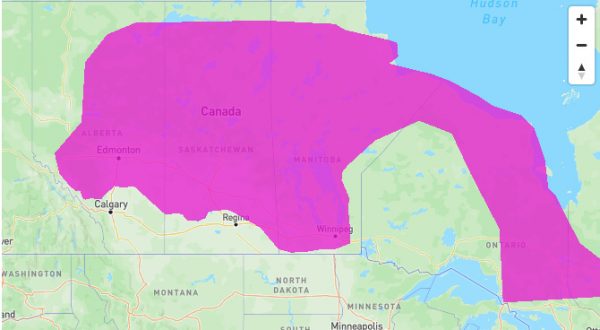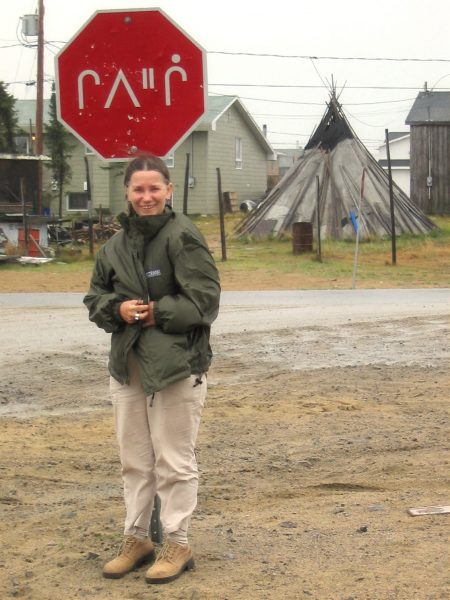First Nations groups in MB: The Ininew
There are five First Nation groups in Manitoba: the Ininew (Cree), the Anishinaabe (Ojibwe), the Oji-Cree, the Denesuline, and the Dakota. These groups are based on the languages they speak.
There are 63 individual First Nation communities in Manitoba. There are 164, 289 First Nation people in Manitoba; this is 12% of the total population. 57.1% of First Nations people live on a reserve, and the rest live in cities or towns.

Image from mfnerc.org. Used by permission.
Purple: Dene
Black: Cree
Green: Oji-Cree
Red: Ojibwe
Blue: Dakota
Where does the word “Cree” come from? This comes from a French word ‘Kristineaux’ but Ininiwok, ‘the people’, or Ininew, ‘speaker of the Cree language’ is what the Cree in Manitoba call themselves. Keep reading to explore Ininew culture, past and present, in Manitoba!
The Ininew (Cree)
The ancestral lands of the Ininew covered most of the Prairies.

Source: Native Land Digital. Disclaimer: The Native Land map does not represent or intend to represent official or legal boundaries of any Indigenous nations.
In the 1700s, the Ininew moved west, from Quebec and Ontario, looking for furs to sell to the French. The Ininew then divided into three groups: Swampy Cree, the Woodland Cree, and the Plains Cree. Together, Ininew are the largest First Nations group in Canada, and there are 44, 666 Ininew people in Manitoba.
Traditional Life
Traditionally, Ininew would move around large areas of land following the animals they hunted for food and supplies. For transportation, they used dogs; later horses; canoes, and snowshoes. Their homes were animal skins or bark draped over pole frames.

Swampy Cree encampment, Shoal River. Archives of Manitoba, Archives of Manitoba photo collection, J.B. Tyrrell Collection no. 5. Shoal River, 1889, N14799. PERMISSION REQUESTED.
They lived in small hunting groups during most of the year. In the summer, they would gather in larger groups to socialize and hold ceremonies. Leaders gained influence through their actions, not because of their family or their wealth.
Community and kinship, connections to people and our world, are key to Ininew culture. One ceremony, the round dance, is an example of how communities are strengthened.
Drumming is sacred in Ininew culture, and the beat of the drum is the described as the heartbeat of the nation.
Language
The Ininew language uses syllabics. One mark can represent multiple syllables, whereas in English each mark, or letter, is a single sound. Here is a stop sign in James Bay, Ontario. The word is pronounced ‘chisasibi’.

Chisasibi, James Bay. Image by Jürgen Thumult from Flickr. Used by permission.
Ininew uses syllabics dating back to the mid 1880’s, but oral tradition is more important in this culture. Oral tradition refers to sharing and preserving information through speech not writing.
There are 22,730 Ininew speakers in Manitoba today, and Ininew is the most popular First Nations language spoken on the Prairies (Manitoba, Saskatchewan, Alberta).
Robert Falcon-Ouellette, a Manitoban, delivered several speeches in Ininew when he was a member of Parliament. He was showing that First Nations languages aren’t dead.
You can learn some Cree today!
Interesting Ininew People
Dr. James Makokis
Dr. James Makokis is from Alberta. He and his husband are winners of The Amazing Race Canada. He is passionate about First Nations rights and trans health.

Retrieved from Alberta Native News. Permission granted for use by Dr. Makokis.
Notorious Cree (James Jones)
An international performer, Notorious Cree, combines hoop dancing and hip hop. He shares online about First Nations culture, and he is very funny! Follow him on online – on Instagram, TikTok, or Twitter!

James Jones, Oregon State University from Flickr CC-BY.
Know more about Notorious Cree and watch his videos in this feature: ‘Notorious Cree’ influencer teaching culture through TikTok.
By Nastashya Wall
Sources: First Nations in Manitoba, Government of Canada; A question of legacy: Cree writing and the origin of the syllabics, Walter Strong, CBC News; Census Profile, 2021 Census of Population, Profile table, StatCan; Cree, The Canadian Encyclopedia; Cree, Indigenous Saskatchewan Encyclopedia; Indigenous Peoples of Manitoba, A Guide for Newcomers, Anika Reynar and Zoe Matties for Mennonite Central Committee Manitoba; and Cree Language, DCPN.ca.
